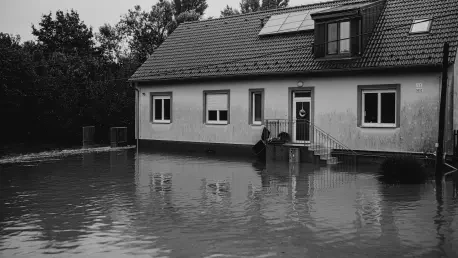In today’s insurance world, escalating catastrophic events have created a complex environment requiring innovative responses. The frequency and intensity of natural disasters like hurricanes and wildfires are prompting insurers to reassess traditional approaches to risk assessment and property coverage. This adaptation is particularly visible in the Excess and Surplus (E&S) market, where dynamic strategies and collaborative relationships define the new norm. Exploring how the industry’s front-runners are meeting these challenges reveals both the obstacles and opportunities reshaping the insurance landscape over recent years.
Shifting Risk Dynamics
Impact of Catastrophic Events
Recent patterns showcase a significant rise in catastrophic events, both in frequency and severity, altering the insurance landscape substantially. These developments include hurricanes and convective storms causing unexpected property losses in regions previously considered immune to such threats. This shift has compelled insurers to enhance their risk assessment methodologies, adapting to an evolving environment where previous tools and strategies may no longer suffice. Utilizing advanced data analytics, insurance companies are now better positioned to analyze and anticipate risks more accurately, allowing for informed decision-making about property coverage and valuation. These advancements are crucial for insurers aiming to remain viable and prepared to meet the increasing demand for robust coverage options.
Transforming Underwriting Practices
The transformation in underwriting practices reflects the necessity for adaptation within a market characterized by increased property valuations and expanding risk profiles. Starting around 2018, catastrophic events like Hurricanes Harvey, Irma, and Maria, and the California wildfires significantly hardened the standard lines property market. The E&S market has responded by integrating more sophisticated data analytics to evaluate property exposures comprehensively and offering coverage from multiple carriers to spread risk. This shift highlights the need for a deeper understanding of existing exposures and emphasizes the importance of using innovative technological tools in underwriting to mitigate risks efficiently and effectively. Such advancements are vital as the industry continues to seek ways to stay ahead in an unpredictable and ever-changing landscape.
Collaborative Partnerships and Valuation
Accurate Property Valuation
Accurate property valuation now stands as an indispensable component of effective risk management in the insurance sector. Underwriters are increasingly relying on sophisticated valuation tools rather than relying solely on property application stated values. These advanced tools offer a nuanced understanding that is critical for setting appropriate limits, determining deductibles, and assessing Probable Maximum Losses (PMLs). Insights from professionals like Tonya Courtney highlight the growing reliance on precise valuation methodologies as part of wider risk mitigation strategies. Proper valuation ensures that coverage is appropriately matched to the risk, fostering a more resilient insurance environment where potential losses are accurately anticipated and prepared for.
Value of Collaborative Partnerships
In the realm of risk management, building trust and consistency in relationships between brokers, carriers, and clients is paramount. Effective collaboration enhances transparency and coordination, leading to more successful risk management and prevention efforts. By fostering robust partnerships, insurance entities ensure greater protection for policyholders, promoting stability within the industry. These relationships facilitate better communication and strategy implementation, streamlining processes that navigate the intricate risk landscape in today’s world. As insurers confront increasingly complex scenarios, the emphasis on collaboration underscores the importance of placing preventive measures and collaborative innovation at the forefront of business practices to tackle dynamic, evolving challenges head-on.
Innovation and Strategic Prevention
Proactive Approaches to Risk Management
In an environment where change is constant, adopting a proactive stance in risk management is emerging as a critical strategy. E&S carriers are at the forefront of this shift, employing data-driven methodologies designed to predict and prevent risks before incidents occur. This forward-thinking mindset places prevention ahead of reaction, leveraging innovative technologies to safeguard properties proactively. By anticipating future threats, insurers can implement targeted measures that reduce potential damages, enhancing policyholder protection and minimizing financial repercussions. The industry’s transition toward innovation not only addresses current challenges but also positions insurers for continued success amidst a landscape marked by growing uncertainties and complexities.
Breaking New Ground with Innovation
The evolving threat landscape necessitates embracing innovation and collaboration as integral parts of the response strategies within the industry. The drive for novel solutions is reshaping the way insurers evaluate and address risks. New technologies enable more precise assessments and closer examinations of potential threats, prompting the adoption of multi-carrier models to distribute risk effectively. These innovative practices reflect a consensus within the industry that traditional approaches are no longer sufficient, emphasizing the need for more sophisticated, agile models. By focusing on innovative and strategic methodologies, insurers are better equipped to navigate the intricate framework of modern risk management, positioning themselves favorably against unforeseen challenges.
Future Considerations and Conclusions
Today’s insurance industry grapples with mounting catastrophic events, creating a multifaceted environment that demands innovative solutions. The increasing regularity and severity of natural calamities such as hurricanes and wildfires are pushing insurers to reevaluate traditional methods of risk assessment and property coverage. This shift is prominently seen in the Excess and Surplus (E&S) market, where dynamic strategies and strong collaborative relationships are becoming the standard. Leading players in the industry are actively addressing these challenges, illustrating both the hurdles and potential that have been reshaping the insurance landscape in recent years. As insurers navigate this evolving terrain, they must embrace new models of operation, foster data-driven insights, and strengthen partnerships to effectively mitigate risks. By collaborating and adapting their strategies, these insurers are not only responding to current threats but are also setting the stage for a more resilient future in the insurance sector.









